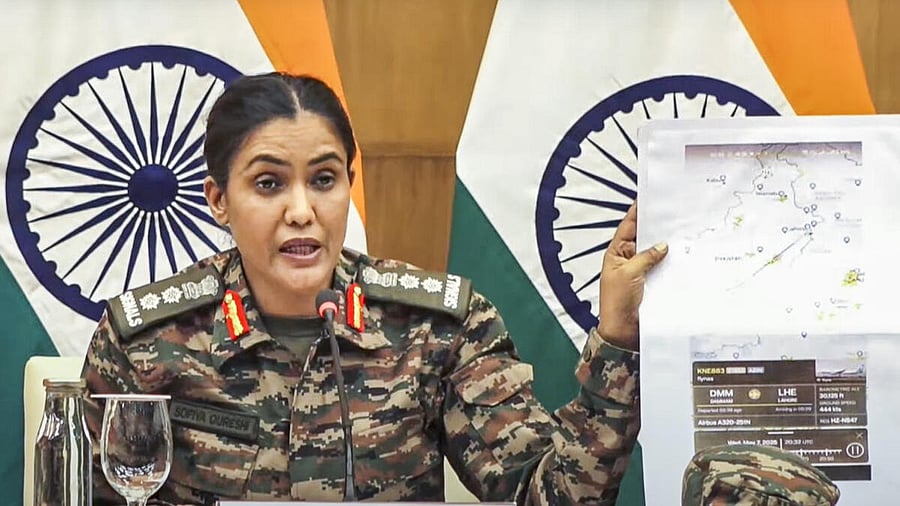
Colonel Sofiya Qureshi speaks during a special briefing on ‘Operation Sindoor’, amid the ongoing India-Pakistan military conflict, in New Delhi.
Credit: PTI Photo
Srinagar/New Delhi: Amid escalating cross-border conflict, Pakistan for the second consecutive day, attacked India with a swarm of drones at 26 sites from Baramulla in the north to Bhuj in the south, along both the International Border and the Line of Control with multiple explosions reported across Jammu and Kashmir and Punjab on Friday evening.
The Pakistani UAVs include suspected armed drones posing potential threats to civilian and military targets, defence officials said.
The drones were spotted at Baramulla, Srinagar, Avantipora, Nagrota, Jammu, Ferozepur, Pathankot, Fazilka, Lalgarh Jatta, Jaisalmer, Barmer, Bhuj, Kuarbet and Lakhi Nala.
Officials said regrettably, an armed drone targeted a civilian area in Ferozpur, resulting in severe injuries to members of a local family. The injured have been provided medical assistance and the area has been sanitised by security forces.
Blasts were heard near Srinagar airport, triggering security responses. Around 9 pm, skies in Punjab districts of Pathankot, Amritsar and Ferozpur were also lit with Pakistan unleashing multiple drones that were neutralized by the air defense. Smoke and flares were seen in the skies amid a complete blackout.
In the national capital, Prime Minister Modi reviewed the situation with Defence Minister Rajnath Singh, National Security Advisor Ajit Doval, Chief of Defence Staff Gen Anil Chauhan and the three Service Chiefs. Rajnath too had a review with the CDS and Chiefs.
The armed forces maintain a high state of alert, and all such aerial threats are being tracked and engaged using counter-drone systems. “The situation is under close and constant watch, and prompt action is being taken wherever necessary,” said an official.
“Citizens, especially in border areas, are advised to remain indoors, limit unnecessary movement, and strictly follow safety instructions issued by local authorities. While there is no need for panic, heightened vigilance and precaution are essential,” he said.
The fresh attack comes a day after Pakistan launched 300-400 drones – some of them are of Turkish origin - at 36 Indian locations along the entire western front Leh to Sir Creek in Gujarat targeting civilian and military establishments besides firing heavy calibre artillery across the LoC inflicting damage in border villages.
Officials said Islamabad also displayed its irresponsible behaviour when it used civilian flights as “aerial shields” by allowing them to fly close to the international border even after launching aerial strikes and fully anticipating counter strikes from India.
“On the night of May 7-8, around 300-400 drones were used to attempt infiltration at 36 locations from Leh to Sir Creek. The possible purpose of such large-scale aerial intrusions was to test air defence systems and collect intelligence,” said Indian Army officer Col Sofiya Qureshi while briefing the media about last night’s action.
The Pakistan army violates Indian airspace several times over the entire western border with the intention of targeting military infrastructure. The Indian armed forces shot down many of these drones using kinetic and non-kinetic means.
“Forensic investigation of the wreckage of the drones is being done. Initial reports suggest that they are Turkish Asisguard Songar drones,” she added.
The Pakistani army resorted to heavy firing across the LoC at Tangdhar, Uri, Poonch, Mendhar, Rajauri, Akhnoor and Udhampur inflicting severe damage on border villages.
An armed UAV was also released targeting Bathinda military station, but it was neutralised by the Indian air defence system.
In response India launched four armed drones and one of them destroyed a Pakistani air defence radar, said Wg Cdr Vyomika Singh, one of the two armed forces officers briefing the media.
The officials pointed out how Islamabad put civilian air passengers at risk without closing the air space in the middle of a conflict situation.
“Pakistan is using civil airliners as a shield, knowing fully well that its attack on India would elicit a swift air defence response. This is not safe for the unsuspecting civil airliners, including the international flights, which were flying near IB between India and Pakistan,” she said.
The reference was to an Airbus 320 flight of Flynas Aviation that originated from Dammam at 1750 Hrs on May 7 and landed later at Lahore at 2110 Hrs in the night.
“Pakistan's irresponsible behavior again came to the fore. Pakistan did not close its civil airspace despite launching a failed unprovoked drone and missile attack on May 7 at 0830 hours in the evening. The IAF demonstrated considerable restraint in its response, thus ensuring safety of international civil carriers,” she said.
Wg Cdr Singh and Col Qureshi shared Flightradar24 data during a high air defence situation in the Punjab sector. “As you have seen, the airspace on the Indian side is absolutely devoid of civil air traffic due to our declared closure. However, there are civil airlines flying the air route between Karachi and Lahore,” Wg Cdr Singh said.
